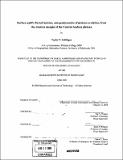| dc.contributor.advisor | Kip V. Hodges and Kelin X. Whipple. | en_US |
| dc.contributor.author | Schildgen, Taylor F. (Taylor Frances) | en_US |
| dc.contributor.other | Massachusetts Institute of Technology. Dept. of Earth, Atmospheric, and Planetary Sciences. | en_US |
| dc.coverage.spatial | sn----- | en_US |
| dc.date.accessioned | 2009-06-30T16:15:49Z | |
| dc.date.available | 2009-06-30T16:15:49Z | |
| dc.date.copyright | 2008 | en_US |
| dc.date.issued | 2008 | en_US |
| dc.identifier.uri | http://hdl.handle.net/1721.1/45774 | |
| dc.description | Thesis (Ph. D.)--Massachusetts Institute of Technology, Dept. of Earth, Atmospheric, and Planetary Sciences, 2008. | en_US |
| dc.description | Includes bibliographical references. | en_US |
| dc.description.abstract | The Colca-Majes and Cotahuasi-Ocona rivers in southwest Peru that cut through the western margin of the Andean plateau en route to the Pacific Ocean incised canyons over 3 km deep in response to late Cenozoic surface uplift. This latest uplift represents a fundamental shift in the style and magnitude of surface deformation that had been ongoing since at least late Cretaceous time, but only relatively recently created what represents the only major barrier to atmospheric circulation in the Southern Hemisphere. Studying canyon incision history as a proxy for surface uplift offers a promising route to understanding how climate and tectonics have interacted throughout the evolution of the Central Andean plateau. In this thesis, a combination of bedrock low-temperature thermochronology (apatite and zircon (UTh)/He techniques), 40Ar/39Ar dating of valley-filling volcanic flows, and three-dimensional thermal modeling using a modified version of Pecube were applied to investigate the incision history of the rivers. Results suggested between 2.6 and 3.0 km of incision occurred in the deepest reaches of the canyons starting at ca. 10 to 11 Ma and ending between 2.3 and 3.5 Ma. The onset of surface uplift that is likely to have driven incision probably did not precede incision by more than one million years, although incision may have continued long after surface uplift ceased. The magnitude and timing of uplift that we infer is in broad agreement with uplift documented along the western margin in northern Chile, in the interior of the Andean plateau, and the eastern margin. Additional work on the style of structural accommodation of this uplift provide important context for interpreting what potential geodynamic mechanisms may have been responsible for this latest tectonic activity. Structural mapping revealed an early history of predominantly reverse fault activity that probably generated the first significant topography in the Central Andes. This compressional period was succeeded by a phase of longwavelenth warping deformation and normal kinematic movement on high-angle faults. | en_US |
| dc.description.abstract | (cont.) This later activity appears to have continued through the latest phase of uplift documented through river incision history, hence was likely responsible for accommodating uplift. Given the broadly synchronous timing of late Cenozoic uplift across the Andean plateau and the style of structural accommodation documented on the western margin, two possible geodynamic mechanisms appear most feasible for generating this latest phase of uplift: lithospheric delamination, and redistribution of ductile material through mid- to lower-crustal flow. Our initial studies of coastal uplift suggest that each is likely to have played a role, although additional work is required to understand how important each may have been in generating uplift. | en_US |
| dc.description.statementofresponsibility | by Taylor F. Schildgen. | en_US |
| dc.format.extent | 154 leaves | en_US |
| dc.language.iso | eng | en_US |
| dc.publisher | Massachusetts Institute of Technology | en_US |
| dc.rights | M.I.T. theses are protected by
copyright. They may be viewed from this source for any purpose, but
reproduction or distribution in any format is prohibited without written
permission. See provided URL for inquiries about permission. | en_US |
| dc.rights.uri | http://dspace.mit.edu/handle/1721.1/7582 | en_US |
| dc.subject | Earth, Atmospheric, and Planetary Sciences. | en_US |
| dc.title | Surface uplift, fluvial incision, and geodynamics of plateau evolution, from the western margin of the Central Andean plateau | en_US |
| dc.type | Thesis | en_US |
| dc.description.degree | Ph.D. | en_US |
| dc.contributor.department | Massachusetts Institute of Technology. Department of Earth, Atmospheric, and Planetary Sciences | |
| dc.identifier.oclc | 318454915 | en_US |
